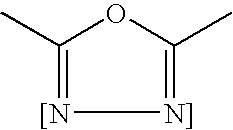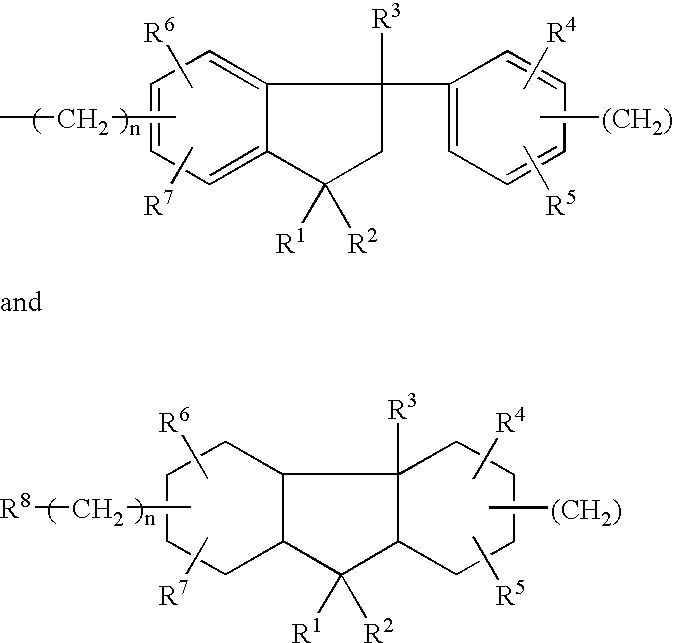Encapsulated toner compositions incorporating organic monomeric glasses
a monomeric glass and composition technology, applied can solve the problems of affecting the fusing characteristics of the toner selected, many prior art cold pressure fixable toner compositions suffer from a number of deficiencies, and the toner is not suitable for use in the field of toner compositions
- Summary
- Abstract
- Description
- Claims
- Application Information
AI Technical Summary
Benefits of technology
Problems solved by technology
Method used
Image
Examples
preparation b
4,4′-isopropylidenebis(2,6-dichlorophenylene) acrylate:methacrylate 50:50
[0117]This monomer was prepared using the apparatus and procedure of Preparation A, with 51.25 g (0.14 mole) of 4,4′-isopropylidenebis(2,6-dichlorophenol), 14.64 g (0.14 mole) of methacryloyl chloride, 12.67 (0.14 mole) of acryloyl chloride and 29.5 g (0.29 mole) of triethylamine. The product was recrystallized from hexane; Tm: 103° C.; Tg: 28-29° C.
Preparation C
4,4′-isopropylidenebis(2,6-dimethylphenylene) dimethacrylate
[0118]This monomer was prepared using the apparatus and procedure of Preparation A from 18 g (0.063 mole) of 4,4′-isopropylidenebis(2,6-dimethylphenol), 13.23 g (0.126 mole) of methacryloyl chloride and 13.4 g of tri ethyl amine.
preparation d
4,4′-isopropylidenebis(2,6-dichlorophenylene) methacrylate:acetate 50:50
[0119]The monomer was prepared using the apparatus and procedure of Preparation A from 51.25 g (0.14 mole) of 4,4′-isopropylidenebis(2,6-dichlorophenol), 14.64 g (0.14 mole) of methacryloyl chloride, 10.99 g (0.14 mole) of acetyl chloride and 18 g of Et3 N. The product was recrystallized from hexane. Although the monomeric materials of preparation A, B, C, and D show crystallinity character, mixing at least any two of these materials produce a amorphous, non-crystallazable mixture.
Preparation E
[0120]Amorphous mixture from 4,′,4′-[benzo(c)furan-3-on-1-ylidene]bis(2,6-dibromophenol) (45 mole %) and 4,4′-isopropylidenebis(2,6-dibromophenol) (55 mole %) condensed with acryloyl chloride (50 mole %) and methacryloyl chloride (50 mole %)
[0121]The following materials were employed: 4,4′-[benzo(c)furan-3-on-1-ylidene]bis(2,6-dibromophenol), 39.37 g (0.0621 mole); 4,4′-isopropylidenebis(2,6-dibromophenol), 41.28 g (0.075...
PUM
 Login to View More
Login to View More Abstract
Description
Claims
Application Information
 Login to View More
Login to View More - R&D
- Intellectual Property
- Life Sciences
- Materials
- Tech Scout
- Unparalleled Data Quality
- Higher Quality Content
- 60% Fewer Hallucinations
Browse by: Latest US Patents, China's latest patents, Technical Efficacy Thesaurus, Application Domain, Technology Topic, Popular Technical Reports.
© 2025 PatSnap. All rights reserved.Legal|Privacy policy|Modern Slavery Act Transparency Statement|Sitemap|About US| Contact US: help@patsnap.com



